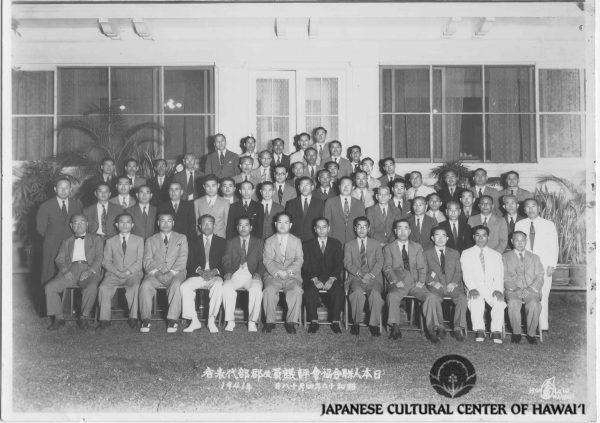Group Media & Photos

United Japanese Society, April 1941. Row 1 (seated, L-R): Totaro Matsui (2nd), Osuke Shigemoto (4th), Kumaji Furuya (5th), Taichi Sato (7th), Koichi Iida (9th), Kyoichi Miyata (12th/1st fr R). Row 2: Yasutaka Fukushima (5th), Sawajiro Ozaki (9th), Sadasuke Terasaki (13th). Row 3: Isoto Dewa (3rd). Row 5: Ryuten Kashiwa (2nd from R). JCCH/ Harriet Masunaga Collection.
Internment Locations
Arrested: December 1941
Sand Island Internment Camp, Honolulu, Oahu Island
A group of 167 Hawaii men (mostly Issei) were sent on the second transfer ship for internment in U.S. Army and Department of Justice camps on the Mainland. Together, the men were sent from camp to camp.
In June 1943, this transfer group was split into two, with this group sent from Camp Livingston to Fort Missoula before being transferred to the Santa Fe Camp.
From there, some internees were paroled to War Relocation Authority camps, where they were reunited with family members. Others were transferred for repatriation to Japan.
Angel Island Detention Facility, California
March 1942 - April 1942
Fort Sill Internment Camp, Oklahoma
April 1942 - May 1942
Camp Livingston Internment Camp, Louisiana
June 1942 - June 1943
Fort Missoula Internment Camp, Montana
June 1943 - March 1944
Jerome Concentration Camp, Arkansas
March 1944 - June 1944
Paroled to New York, New York
Returned to Hawaii: July 1945
In the summer of 1945, the U.S. Army allowed ten of Hawaii's 160 internees with sons serving in the military to return to the islands. Three of Kyoichi Miyata's sons -- Norman Shinzo, Robert Shigeo, and Charles Atsumi -- served in the U.S. armed forces during World War II. Norman and Robert Miyata were members of the 442nd Regimental Combat Team.
Other internees with soldier sons who returned in summer 1945 were Ryosei Aka, Ryozo Izutsu, Kichitaro Kawauchi, Kametaro Maeda, Teiichiro Maehara, Tamehachi Makihira, Nobuichi Miura, Hanzo Shimoda, and Nekketsu Takei.
In the years before the war, Miyata served as an executive officer of the Honolulu Japanese Merchants' Association and was an active member of the United Japanese Society.
